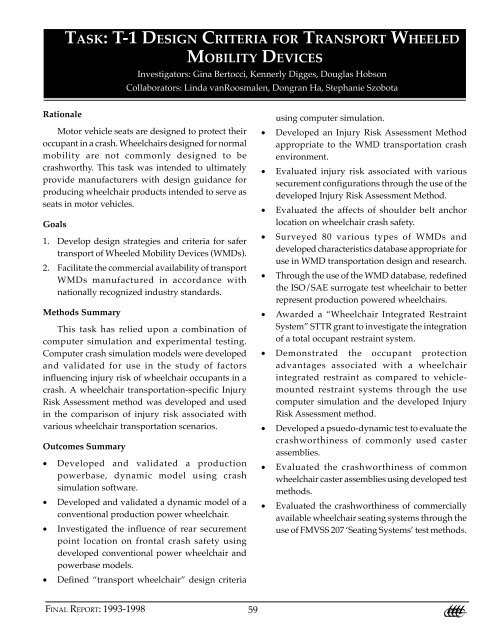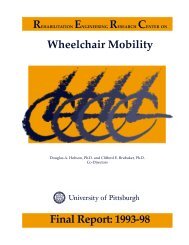T-1 Design Criteria for Transport Wheeled Mobility Devices
T-1 Design Criteria for Transport Wheeled Mobility Devices
T-1 Design Criteria for Transport Wheeled Mobility Devices
You also want an ePaper? Increase the reach of your titles
YUMPU automatically turns print PDFs into web optimized ePapers that Google loves.
TASK: T-1 DESIGN CRITERIA FOR TRANSPORT WHEELED<br />
MOBILITY DEVICES<br />
Investigators: Gina Bertocci, Kennerly Digges, Douglas Hobson<br />
Collaborators: Linda vanRoosmalen, Dongran Ha, Stephanie Szobota<br />
Rationale<br />
Motor vehicle seats are designed to protect their<br />
occupant in a crash. Wheelchairs designed <strong>for</strong> normal<br />
mobility are not commonly designed to be<br />
crashworthy. This task was intended to ultimately<br />
provide manufacturers with design guidance <strong>for</strong><br />
producing wheelchair products intended to serve as<br />
seats in motor vehicles.<br />
Goals<br />
1. Develop design strategies and criteria <strong>for</strong> safer<br />
transport of <strong>Wheeled</strong> <strong>Mobility</strong> <strong>Devices</strong> (WMDs).<br />
2. Facilitate the commercial availability of transport<br />
WMDs manufactured in accordance with<br />
nationally recognized industry standards.<br />
Methods Summary<br />
This task has relied upon a combination of<br />
computer simulation and experimental testing.<br />
Computer crash simulation models were developed<br />
and validated <strong>for</strong> use in the study of factors<br />
influencing injury risk of wheelchair occupants in a<br />
crash. A wheelchair transportation-specific Injury<br />
Risk Assessment method was developed and used<br />
in the comparison of injury risk associated with<br />
various wheelchair transportation scenarios.<br />
Outcomes Summary<br />
• Developed and validated a production<br />
powerbase, dynamic model using crash<br />
simulation software.<br />
• Developed and validated a dynamic model of a<br />
conventional production power wheelchair.<br />
• Investigated the influence of rear securement<br />
point location on frontal crash safety using<br />
developed conventional power wheelchair and<br />
powerbase models.<br />
• Defined “transport wheelchair” design criteria<br />
using computer simulation.<br />
• Developed an Injury Risk Assessment Method<br />
appropriate to the WMD transportation crash<br />
environment.<br />
• Evaluated injury risk associated with various<br />
securement configurations through the use of the<br />
developed Injury Risk Assessment Method.<br />
• Evaluated the affects of shoulder belt anchor<br />
location on wheelchair crash safety.<br />
• Surveyed 80 various types of WMDs and<br />
developed characteristics database appropriate <strong>for</strong><br />
use in WMD transportation design and research.<br />
• Through the use of the WMD database, redefined<br />
the ISO/SAE surrogate test wheelchair to better<br />
represent production powered wheelchairs.<br />
• Awarded a “Wheelchair Integrated Restraint<br />
System” STTR grant to investigate the integration<br />
of a total occupant restraint system.<br />
• Demonstrated the occupant protection<br />
advantages associated with a wheelchair<br />
integrated restraint as compared to vehiclemounted<br />
restraint systems through the use<br />
computer simulation and the developed Injury<br />
Risk Assessment method.<br />
• Developed a psuedo-dynamic test to evaluate the<br />
crashworthiness of commonly used caster<br />
assemblies.<br />
• Evaluated the crashworthiness of common<br />
wheelchair caster assemblies using developed test<br />
methods.<br />
• Evaluated the crashworthiness of commercially<br />
available wheelchair seating systems through the<br />
use of FMVSS 207 ‘Seating Systems’ test methods.<br />
FINAL REPORT: 1993-1998<br />
59
Drop<br />
Wghts.<br />
Applied<br />
Force<br />
Caster<br />
Test<br />
Fixture<br />
Figure 42 – Dynamic Drop Testing of Caster Assemblies<br />
Figure 43 – FMVSS 207 Seating System Testing of Wheelchair Seats<br />
Recommended Future Research<br />
Future research ef<strong>for</strong>ts will focus on the<br />
crashworthiness of wheelchairs and their components<br />
in rear and side impact scenarios. Additional ef<strong>for</strong>ts<br />
related to the study of frontal impact will concentrate<br />
on the development and validation of a computer<br />
model to predict occupant submarining when seated<br />
in a wheelchair. Various seating characteristics will<br />
be evaluated to determine their influence on injury<br />
risk and in particular submarining.<br />
Publications<br />
Bertocci GE, Digges K, Hobson D, Development of<br />
<strong>Transport</strong>able Wheelchair <strong>Design</strong> <strong>Criteria</strong> Using Computer<br />
Crash Simulation. IEEE Transactions on Rehabilitation<br />
Engineering, Vol 4, No 3, Sept. 1996: 171-181.<br />
Bertocci GE, Digges K, Hobson DA, Shoulder Belt Anchor<br />
Location Influences on Wheelchair Occupant Crash<br />
Protection. Journal of Rehab Research and Devel, Vol 33,<br />
No 3, July 1996:279-289.<br />
Bertocci GE, Karg, P, Hobson D, <strong>Wheeled</strong> <strong>Mobility</strong> Device<br />
Database <strong>for</strong> <strong>Transport</strong>ation Safety Research and<br />
Standards. Assistive Technology, Vol 9.2, 1997.<br />
60 RERC ON WHEELCHAIR TECHNOLOGY
Bertocci GE, Esteireiro J, Cooper RA, Young TM, Thomas<br />
C, Testing and Evaluation of Wheelchair Caster Assemblies<br />
Subjected to Dynamic Crash Loading. To appear in Journal<br />
of Rehab Research and Development, Vol 36, No. 1, January<br />
1999.<br />
Bertocci GE, Digges, K, Hobson DA, Computer Simulation<br />
and Sled Test Validation of a Powerbase Wheelchair and<br />
Occupant Subjected to Frontal Crash Conditions. To appear<br />
in IEEE Trans Rehab Engr, Vol 7, No 2, June 1999.<br />
Bertocci GE, Digges, K, Hobson DA, Development of a<br />
Wheelchair Occupant Injury Risk Assessment Method and<br />
Its Application in the Investigation of Wheelchair<br />
Securement Point Influence on Frontal Crash Safety.<br />
Conditionally accepted in IEEE Transactions on<br />
Rehabilitation Engineering, Nov. 1997.<br />
Digges K, Bertocci GE, Application of the ATB Program to<br />
Wheelchair <strong>Transport</strong>ation. Technical Report #3,<br />
University of Pittsburgh RERC, Nov 1995.<br />
Bertocci GE, Hobson D, The Affects of Securement Point<br />
Location on Wheelchair Crash Response. Proceedings of<br />
the RESNA ‘96 Annual Conference RESNA Press,<br />
Washington DC, June 1996.<br />
VanRoosmalen, L, Ha, D, Bertocci, G, Karg, P, Szobota, S,<br />
An Evaluation of Wheelchair Seating System<br />
Crashworthiness Using Federal Motor Vehicle Safety<br />
Standard (FMVSS) 207 Testing, Submitted to RESNA ’99<br />
Conf, Dec, 1998.<br />
Bertocci GE, Esteireiro J, Cooper RA, Young TM, Thomas<br />
C, Testing and Evaluation of Wheelchair Caster Assemblies<br />
Subjected to Dynamic Crash Loading. Proceedings of RESNA<br />
‘98 Annual Conference, June 1998.<br />
Karg P, Bertocci GE, Hobson DA, Status of Universal<br />
Interface <strong>Design</strong> Standard <strong>for</strong> <strong>Mobility</strong> Device Docking on<br />
Vehicles. Proceedings of the RESNA ‘98 Annual Conference,<br />
June 1998.<br />
Van Roosmalen L, Bertocci GE, Karg PE, Young TM, Belt<br />
Fit Evaluation of Fixed Vehicle Mounted Shoulder Restraint<br />
Anchor Across Mixed Occupant Populations. Proceedings<br />
of the RESNA ‘98 Annual Conference, June 1998.<br />
Bertocci GE, Development of <strong>Transport</strong>able Wheelchair<br />
<strong>Design</strong> <strong>Criteria</strong> Using Computer Crash Simulation.<br />
Proceedings of 1998 Articulated Total Body Modeling<br />
Conference, April 1998.<br />
Bertocci GE, The Affects of Shoulder Belt Anchor Position<br />
on Wheelchair <strong>Transport</strong>ation Safety. Proceedings of the<br />
RESNA ‘95 Annual Conference. RESNA Press, Washington,<br />
DC, 1995: 311-313.<br />
Bertocci GE, Karg P, Hobson D, Wheelchair Classification<br />
System and Database Report, Technical Report #6,<br />
University of Pittsburgh RERC on Wheelchair <strong>Mobility</strong>,<br />
Pittsburgh, PA 1996.<br />
Bertocci GE, Digges K, Hobson D, The Affects of<br />
Wheelchair Securement Point Location on Occupant Injury<br />
Risk. Proceedings of the RESNA ’97 Annual Conference,<br />
RESNA Press, Washington DC, Jan 1997. Recipient of 1997<br />
RESNA/Whitaker Scientific Paper Competition Award.<br />
Bertocci GE, Karg PE, Survey of <strong>Wheeled</strong> <strong>Mobility</strong> Device<br />
<strong>Transport</strong> Access Characteristics. Proceedings of the<br />
RESNA ’97 Annual Conference, RESNA Press, Washington<br />
DC, Jan 1997.<br />
Bertocci GE, Ph.D. Dissertation: The Influence of<br />
Securement Point and Occupant Restraint Anchor Location<br />
on Wheelchair Frontal Crash Safety, July 1997.<br />
FINAL REPORT: 1993-1998<br />
61




